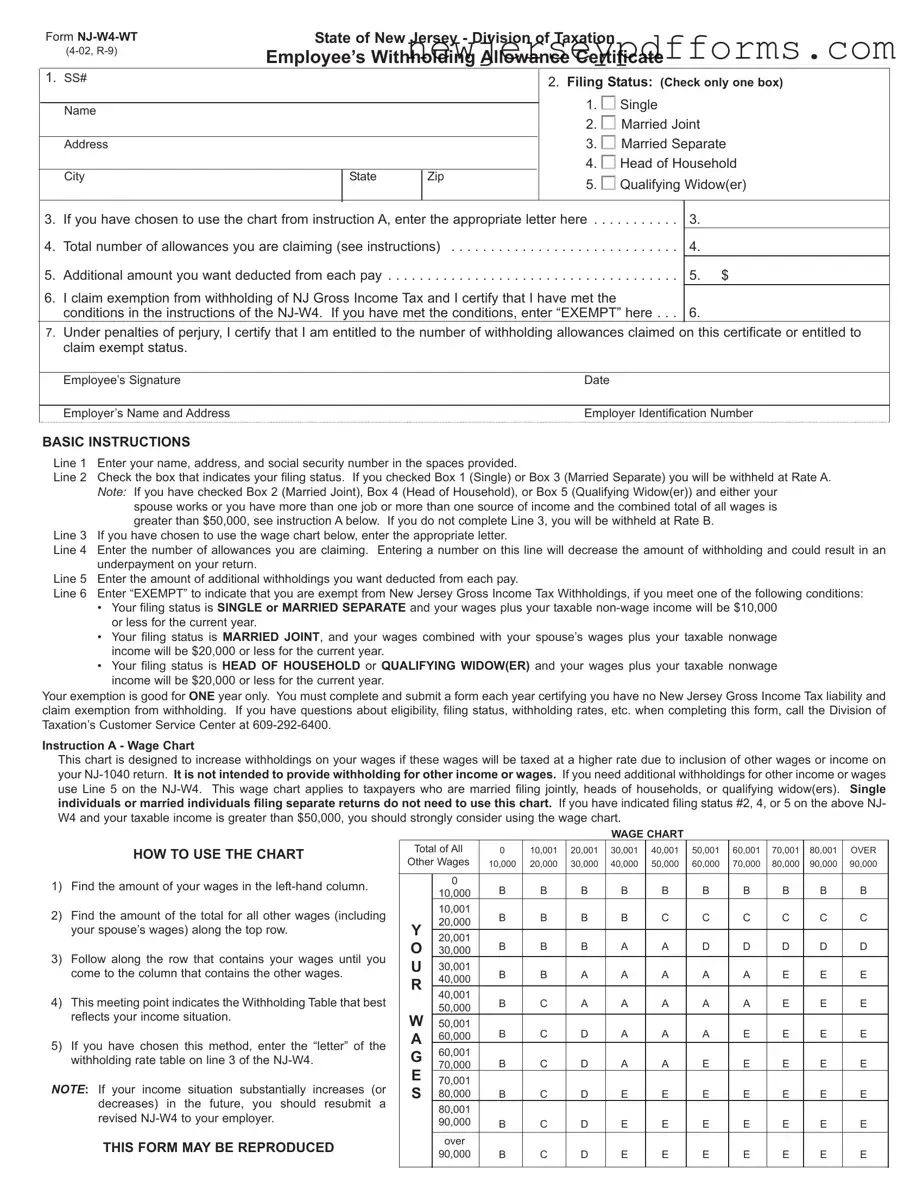The NJ W-4 WT form is similar to the IRS Form W-4, which is used by employees to determine how much federal income tax should be withheld from their paychecks. Both forms require employees to provide personal information, such as their name and Social Security number. They also ask for the employee's filing status and the number of allowances claimed. The primary difference lies in the fact that the NJ W-4 WT focuses on New Jersey state income tax, while the IRS Form W-4 pertains to federal tax obligations. Both forms allow for adjustments in withholding based on personal circumstances, ensuring that employees are not over- or under-withheld throughout the year.
Another document similar to the NJ W-4 WT is the California Form DE 4. This form is used for state income tax withholding in California. Like the NJ W-4 WT, the DE 4 requires information about the employee's filing status and allows for the declaration of allowances. Both forms aim to help employees manage their tax withholdings effectively. However, the DE 4 may include different allowances and exemption criteria specific to California tax law, reflecting the unique tax structure of that state.
The New York State IT-2104 form also shares similarities with the NJ W-4 WT. This form is used by New York employees to determine their state income tax withholding. Both documents require personal information, filing status, and the number of allowances. Additionally, both forms allow for the declaration of additional withholding amounts. However, the IT-2104 includes specific instructions and calculations tailored to New York tax regulations, which may differ significantly from New Jersey's tax rules.
The Massachusetts Form M-4 is another document that resembles the NJ W-4 WT. This form is used to establish the amount of state income tax withholding for employees in Massachusetts. Both forms require the employee's personal details and filing status, along with the number of allowances claimed. Additionally, both forms allow for adjustments in withholding. The M-4, however, has its own set of rules and exemptions that are specific to Massachusetts tax law, which may not apply in New Jersey.
The Pennsylvania Form REV-419 is similar to the NJ W-4 WT in that it is used for state income tax withholding. This form requires personal information, filing status, and the number of allowances claimed. Both documents serve the same purpose: to ensure the correct amount of state tax is withheld from an employee's paycheck. However, the REV-419 is specific to Pennsylvania and includes unique provisions that reflect Pennsylvania's tax laws.
The Illinois Form IL-W-4 is another comparable document. This form is used by employees in Illinois to determine their state income tax withholding. Like the NJ W-4 WT, the IL-W-4 requires personal information and allows for the declaration of allowances. Both forms aim to help employees manage their tax withholdings. However, the IL-W-4 includes instructions specific to Illinois tax regulations, which may differ from those in New Jersey.
The Texas Employee's Withholding Certificate is also akin to the NJ W-4 WT, although Texas does not have a state income tax. This certificate is used for federal withholding purposes, but it serves a similar function by collecting personal information and determining withholding allowances. While the NJ W-4 WT focuses on state tax, the Texas form is primarily concerned with federal tax withholdings, reflecting the unique tax structure of Texas.
When engaging in various financial activities, such as completing tax forms like the NJ W-4 WT or IRS Form W-4, it is essential to understand the documents involved. For instance, a well-structured PDF Document Service can provide helpful templates for releases of liability, allowing individuals and organizations to protect themselves from unforeseen claims while managing their financial responsibilities.
The Virginia Form VA-4 shares similarities with the NJ W-4 WT as it is used for state income tax withholding in Virginia. Both forms require personal information and the number of allowances claimed. They both serve the purpose of ensuring the correct amount of state tax is withheld from employees' paychecks. However, the VA-4 contains specific guidelines and exemptions pertinent to Virginia's tax laws, which differ from those in New Jersey.
Lastly, the Florida Employee's Withholding Certificate is somewhat similar to the NJ W-4 WT in that it gathers information for tax withholding purposes. However, Florida does not impose a state income tax, so this form is primarily used for federal withholding. While both documents collect personal information and allow for adjustments, the Florida form is less complex due to the absence of state income tax obligations.
